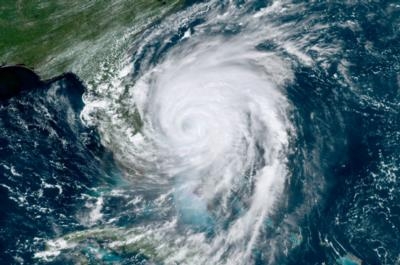Patented Approach Focuses Microwaves From Platforms in Space To Interrupt Formation Of Tropical Depressions
Bruce Morton, a retired aerospace engineer & rocket scientist who resides in Northern Virginia and St. Thomas, US Virgin Islands, has developed a concept to prevent or interfere with the formation of hurricanes. He filed a patent application in May 2019 designed to interfere with and interrupt the storm system while it is still a tropical depression, and prevent it from forming into a much more powerful Tropical Storm and subsequently into a much more powerful Hurricane.

The concept, which is explained in more detail in the patent application, is that solar radiation is collected by large solar arrays on one or more platforms in space and converted to microwave energy. The microwave energy is then transmitted to earth and directed to and constantly focused on one or more non-symmetrical segments of a generally circular and slowly rotating tropical depression, which is a precursor to a tropical storm and then a hurricane (alternatively called a cyclone or typhoon). The focused microwave energy interrupts the cycle of vertical upward and downward movement of air, water, & water vapor, and destabilizes the developing rotational motion of the tropical depression, causing it to break up and dissipate, and preventing it from ultimately developing into a tropical storm and then into a hurricane.
The typical output from each space based platform might be on the order of thousands of megawatts (for reference, the 2012 net generation capability of Three Mile Island nuclear power plant was 829 MW). Positioning such platforms in space would require multiple rocket launches to get the required equipment into orbit. While several years ago the launch costs might have been close to prohibitive, launch costs have decreased significantly with the advent of commercial space launch capability, which helps make the concept much more affordable. Further, when not focusing microwave energy on a tropical depression, the microwave energy can alternatively be used to create earth based solar energy, which would help alleviate costs of operating the system solely for hurricane prevention.
Tropical depressions typically form over the open ocean in international waters, and are typically identified and tracked. Ships and aircraft receive danger notices/warnings to avoid the area and stay away, although research vessels and aircraft occasionally venture into the danger area for research purposes. Thus, an additional notice to airmen and warning to mariners would be issued in advance prior to focusing microwave energy on the tropical depression.
The annual hurricane season in the Northern hemisphere generally begins at the beginning of June and runs through the end of November, with major hurricane activity often beginning in mid-August. Although we can track hurricanes, attempts over the years to influence them or diminish their strength by seeding from aircraft and other approaches have been generally unsuccessful.
Mr. Morton is an experienced aerospace engineer and rocket scientist. He retired from Lockheed Martin in Apr. 2010, and still works in the aerospace, intelligence and defense business. He currently resides in Northern Virginia and in St. Thomas, US Virgin Islands.
(Source: Bruce Morton news release)
 ANN's Daily Aero-Term (12.19.25): Ultrahigh Frequency (UHF)
ANN's Daily Aero-Term (12.19.25): Ultrahigh Frequency (UHF) NTSB Prelim: Cirrus Design Corp SR22T
NTSB Prelim: Cirrus Design Corp SR22T Classic Aero-TV: The Red Tail Project--Carrying the Torch of the Tuskegee Airmen
Classic Aero-TV: The Red Tail Project--Carrying the Torch of the Tuskegee Airmen Aero-News: Quote of the Day (12.19.25)
Aero-News: Quote of the Day (12.19.25) Airborne 12.17.25: Skydiver Hooks Tail, Cooper Rotax Mount, NTSB v NDAA
Airborne 12.17.25: Skydiver Hooks Tail, Cooper Rotax Mount, NTSB v NDAA



